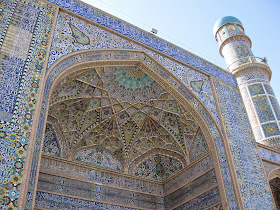Before getting into my book report on the seventh surah of the Qur'an, I want to talk a little about Islamic art. Traditionally, Muslims have viewed visual representations of people and animals as blasphemous. The reason is that humans cannot adequately represent God or his creation--to do so is like competing with God (a losing proposition). Because of this, a different style of art emerged in the Islamic world that is very distinct from "western" art. Rather than focusing on the human figure or landscapes, Islamic art focuses on text (specifically Arabic calligraphy), geometric patterns, and arabesque designs. This is why, for my book report on the Qur'an, I am not including figurative paintings (like I did for my book report on the Bible). Such paintings are very rare, unlike Biblical paintings (which dominate the museums of Europe). This is not to say that one tradition (Christian or Islamic) is better than the other--they are just different. Islamic art and architecture is some of the most beautiful (and complex) in the world. Here, for example, is the exterior of a mosque in Herat, Afghanistan. Note the text and patters.
That being said, there is a lesser-known tradition of Islamic art that does, in fact, include figures, and it is this tradition that I want to include with my book report on the seventh surah of the Qur'an, entitled "The Heights." From a very early date, a popular type of Islamic literature was called Qisas Al-Anbiya (or "Stories of the Prophets"). These included, as you might expect, stories of Islamic prophets. Some of these prophets are also in the Bible, but some are unique to Islam. In the 16th century Ottoman Empire (which was largely Muslim), some manuscripts of "Stories of the Prophets" were created WITH ILLUSTRATIONS! Imagine my excitement when I found these. Being a visual person, I couldn't resist including some of these illustrations in my book report. The surah entitled "The Heights" gives stories of some prophets, which I will re-tell here, with illustrations from the 16th century Ottoman "Stories of the Prophets." Here are some prophets I learned about:
1.) Hud was an ancient Arabian prophet from the region of Ad, which some scholars believe is modern Yemen. Hud is believed to be a descendent of Noah (also a prophet), and Hud even gets his own surah of the Qur'an (the eleventh one). Like most prophets, Hud's main purpose (according to the Qur'an) was to get people to stop being polytheists, and to believe in the one God.
 |
| Hud, the Prophet from Ad. |
 |
| The prophet Salih shows his people the She-Camel from God. |
 |
| Tomb/shrine to Shu'ayb in Jordan. |

